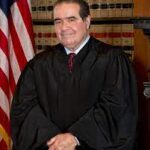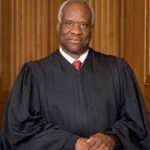Check out the website: https://lenspoliticalnotes.com Look at the recent Political Notes and Len’s Letters on the website:
April 25th, 2023 Len’s Letter #62. A Well Regulated MilitiaGeneral Election


Justice Antonin Scalia Justice Clarence Thomas


Historian Vernellia Randall Historian Gregory Ablavsky
I am not a lawyer, though I know a few. I am not an historian, though I majored in history. Those are not great credentials for writing about one of the most serious legal and historical issues facing the United States of America. I know there are controversies about the 2nd Amendment to the US Constitution and Justice Thomas’s direction to us all regarding the regulation of guns. Despite my limitations, I will write about the issue.
Justice Thomas spoke about what he saw as limitations on the regulation of the Right to Bear Arms:
“To justify its regulation, the government may not simply posit that the regulation promotes an important interest. Rather, the government must demonstrate that the regulation is consistent with this Nation’s historical tradition of firearm regulation. “
What then is our historical tradition of firearm regulation? Since this is Justice Thomas speaking, we can and should take his originalism seriously and especially consider our traditions from the time preceding the creation of the US Constitution, discussions during the creation of the Constitution, and the implementation of the Constitution shortly after its passage.
Militias have a place in the constitution. Article I, Section 8, Clause 16 says:
“Congress shall have the power … to provide for organizing, arming, and disciplining, the Militia, and for governing such Part of them as may be employed in the Service of the United States, reserving to the States respectively, the Appointment of the Officers, and the Authority of training the Militia according to the discipline prescribed by Congress.”
In addition, Article II, Section 2, Clause 1 says:
The President shall be Commander in Chief of the Army and Navy of the United States, and of the Militia of the several States, when called into the actual Service of the United States.
These Constitutional Articles call for the federal government to regulate militias. In doing so, because virtually every able-bodied man was part of a militia, typically a state militia, the newly created government had the authority to regulate firearms. Regulation of the men and weapons of the militias was regulating everyone who bore arms.
In 1995, Vernellia Randall wrote a history of the American militia. In the 17th century, she said: “….colonial militia laws required every able-bodied male citizen to participate and to provide his own arms. Militia control was very localized, often with individual towns having autonomous command systems.”
She added: “With the outbreak of war, the colonial militias composed the bulk of the armies that eventually won independence. The experiences of the Revolutionary War had instilled most Americans with great confidence toward their militias and distrust of standing armies. Many concluded that a standing army was the tool of an absolutist government and that the militia was the proper means for a free people to defend against such a regime.”
Discussing the place the militias had in the Constitution, she wrote: “…the drafters believed the militia served three purposes. First, the militia served in place of a standing army to resist foreign aggression. Second, the militia served as an internal police force for the states. Third, following the establishment of the federal government, the militia served to resist or deter the use of a federal standing army against the states. The eighteenth-century militia was well structured and equipped to fulfill each of these three purposes.”
Twenty-five years later, another student of American Militias, Gregory Ablavsky, wrote: “..the militia was the community under arms: (Bold – LJL) all able-bodied free men under a certain age (later limited in most states to white men) were obligated to serve. A combination of both military unit and police, they were often the only way for governments in early America to exert force.”
Ablavsky added: “Militia and community were closely intertwined in early America: militias were supposed to protect the community’s interests. Of course, who constituted the community in the early United States was heavily racialized. Militias policed against the ever-present threat of resistance by enslaved Africans…”
This is not to say that the states succeeded in what they organized Militias to achieve. Randall stated: “The first [Congressional] legislation [related to Militias] was the Militia Act of 1792. This act codified the traditional view of the militia as consisting of all able- bodied citizens. It also required each militiaman to supply his own arms. However, since the federal government provided no funding, the states gradually allowed their militias to deteriorate. By the 1870s, the militias in most states were little more than social clubs centered on a yearly parade.”
Consider the purpose of the 2nd Amendment to the US Constitution
“A well regulated Militia, being necessary to the security of a free State, the right of the people to keep and bear Arms, shall not be infringed.”
The 2nd Amendment appears to have been intended to address the third purpose that Randall identifies for the state militias: “ to resist or deter the use of a federal standing army against the states.” There were circumstances where those supporting the then proposed Bill of Rights could imagine a state intending to defy the federal government –by seceding or by, say, rejecting a tax imposed on people in the states. If the federal government had the authority to “infringe” on the “right of people to keep and bear arms” the state would lose its capacity to maintain its militia and be unable to oppose the federal government effectively.
The possibility that a state might lose its militia and be unable to oppose the federal government brings us to Justice Scalia’s majority opinion in District of Columbia v Heller.
Oyez (a Kent and Cornell legal project) explains: “The Court held that the first clause of the Second Amendment that references a “militia” is a prefatory clause that does not limit the operative clause of the Amendment. Additionally, the term “militia” should not be confined to those serving in the military, because at the time the term referred to all able-bodied men who were capable of being called to such service.”
Oyez continued: “To read the Amendment as limiting the right to bear arms only to those in a governed military force would be to create exactly the type of state-sponsored force against which the Amendment was meant to protect people. Because the text of the Amendment should be read in the manner that gives greatest effect to the plain meaning it would have had at the time it was written, the operative clause should be read to “guarantee an individual right to possess and carry weapons in case of confrontation.”
In my view, the Justice Scalia’s Heller decision did not have proper regard to the opening segment of the 2nd Amendment to the constitution. Effective maintenance of militias by states protecting their sovereignty against the central government, required regulating the people bearing arms in those militias and their weaponry. The operative clause is “A well regulated Militia, being necessary to the security of a free State…”. The federal government was prohibited from infringing on the right to bear arms, but not the states. Because the Militia involved every able-bodied man, each state would exercise its authority to regulate the arms borne by those men and the central government should not interfere.
Did the 2nd amendment obviate federal authority in Article I, Section 8, Clause 16 and Article II, Article II, Section 2, Clause 1? It may not have been quite as definitive as that. Did it leave open a kind of competition that depended on where the will of the people became manifest? If the will of the people was with federally organized Militias, it was one thing. If the will of the people was with a state Militia, it was something else. The post civil war amendments to the constitution did not settle the question. The Civil War itself settled it. The Militias organized by the southern states were so soundly defeated by the military of the United States Government, there was little to say about infringing on the rights of states to create well-regulated militias. What little there was to say, was said by General Grant. General Grant’s actions demonstrated the federal government’s authority. After General Lee’s surrender, Grant, who well understood that he could have been more draconian, arranged for the defeated southern soldiers to be fed and allowed them to keep any horses they owned and their side arms.
To emphasize the issue of regulating militias, consider the history of militias. An historian might look to 13thcentury England for the idea of militias. The Statute of Winchester in 1285 reads: “Every man shall have in his house arms for keeping the peace according to the ancient assize.”
Or an historian might consider the 1581 warning of a consequence “If any man being the Queenes Subject, and not having reasonable cause or impediment, and being within the age of sixtie years (except spiritual men, justices of the bench, or other justices of Assise, or barons of the Exchequer) have not a long bow and Arrowes readie in his house, or have not for every man childe in his house betweene seven years and seventeene of age a bow and two shaftes, and everie such being above seventeene years, a Bowe and foure shaftes, or have not brought them uppe in Shooting: if any man under the age of four and twentie years, have shotte at standing pricks [targets] (being above that age) have shot at any marks under eleven score yards with any prickshaft or flight.” The monarch’s government regulated who must have weapons, the weapons they must have, and their training.
Consider the history of American militias as well. The US National Guard traces its origin to the 17th century – to the creation of a Massachusetts Militia. As Ablavsky stated: “the militia was the community under arms.” (Bold again by LJL) Massachusetts sought and required uniforms and weapons from England in specific detail for this militia.
By the pre-revolutionary period, in the 1760s, the British were embargoing firearms, weapons parts, and ammunition from the American colonies. In response, the Massachusetts Colony attempted to create its own well-regulated militia – regulating the uniforms to be worn and weapons to be used. Other colonies did the same – in each case creating their own “community under arms.”
Because the regulation of the communities under arms, was undertaken colony by colony, the well-regulated militias in each colony that would eventually become a state, used different firearms. Some used the short, heavy, smooth bored musket, loaded at the muzzle and, therefore, easy and quick to load. The musket was a weapon you could attach a bayonet to. But smooth bored muskets were less accurate than a weapon that was “rifled.” A rifle had grooves in the barrel which created spin and increased accuracy. Rifles were not loaded at the muzzle, could not have bayonets attached. They were more complicated and slower to load and did not have the advantage of a bayonet. Militia men with rifles had to use a tomahawk for close fighting instead.
Consider the weapons of the militias of three nearby states: Pennsylvania, Delaware, and Maryland. Pennsylvania, a state run by Quakers, was the only colony without a tradition of a militia. Recognizing the need for a militia at the time of the Revolution, Pennsylvania’s soldiers became famous for their long rifles. Pennsylvania’s standard long rifle had greater range and accuracy than muskets. Some fans of the Pennsylvania long rifle have seen it as crucial for the American victory in the revolution against the muskets of the British army and compared to the detriment of the muskets of other militias. Revisionists disagree. For our purposes, what is important is that, for Pennsylvania, its community under arms, through direction from the state, used a distinctive weapon.
Maryland had distinctive uniforms and weapons. The Journal of the American Revolution reported that each Marylander “began the war with uniforms, an advantage over many other Continentals. Uniforms were not only useful clothing, but also contributed to esprit-de-corps and morale, not to mention physical well-being. Each man had both musket and bayonet, or rifle and tomahawk”. Primarily, Marylanders used a musket – either a long one or a short one. Short ones had a 42” barrel (think 6” longer than a yardstick). This is not to say that enforcement was as universal as the expectation. Marylanders who showed up with a civilian weapon or even a weapon used for shooting birds were not rejected from this community under arms.
The single Delaware regiment was equipped with muskets and bayonets. The soldiers in the regiment used either the Brown Bess English musket or the Charlesville French musket. Each of these weapons could attach a bayonet. The tactics developed by the Delaware regiment reflected the weapons its militiamen were called on to use.
Consider how the following timeline illuminates state and/or federal authority over militias.
- The Confederation Congress founded the Springfield Armory.It was initially a place to store weapons, to distribute those weapons to colonies and their militias which needed them.
January, 1787. In what came to be known as Shay’s Rebellion, a large band of Massachusetts farmers, in debt, insufficiently paid for their military service, attacked the Springfield Armory to add to the weaponry to prepare themselves for a march on Boston. Defeated by a better organized state Militia, they never got to Boston.
May, 1787. The Constitutional convention convened to write the document that replaced the Articles of Confederation with a more centralized government. That new document included the Articles discussed above about federal control of the militias.
September, 1787. The Founding Fathers finished writing and signed the constitution.
June, 1789. James Madison submitted proposed amendments to the US Constitution that. Those that were ratified became what we know as the Bill of Rights. Among those rights was the 2nd Amendment – intended to preserve the existence of State Militias and to prohibit the new centralized government from infringing on the “right to bear arms.” States were expected to oversee, to be in charge of their militias. Part of being in charge included independent state decisions about the weapons the members of their Militia should hold. States infringed on the “right to bear arms” by telling their citizens what arms they should bear. This is not to say that states prohibited “the people” from having weapons other than the ones needed for the state Militia. It is just that such a right was not central to the purpose of the amendment, which was to ensure the right of states to have and control their militia.
The Militia Act passed by the US Congress which codified the commonplace organization of Militias reminds us that the federal government retained some authority over the state militias, enough authority so that, in 1860, the federal government went to war against the seceding Southern states and the armies created under what they understood to be their authority over their militias
April 9, 1865 Lee Surrenders to Grant.
14th Amendment ratified. The amendment specified that states may not “deprive any person of life, liberty, or property without the due process of law, nor deny to any person …the equal protection of the laws.” While the authority of states to maintain militias may have been weakened by the Civil War itself and the state militias that remained may have turned into mere clubs, the state obligation based on the 14th Amendment regarding the militias and their members or potential members was to regulate fairly, equally, and according to law.
In preparing to write this piece and while writing it, I became convinced that the central and controlling phrase of the 2nd Amendment was the language previously dismissed as merely an introduction: “A well regulated Militia, being necessary to the security of a free State…” The Amendment targeted the new federal government. It was the federal government which was barred from infringing on the “right to bear Arms.” The 14th Amendment did not extend that infringement prohibition to the states. States were still protected in their right to have militias and their right to regulate them. In regulating them, they would regulate everyone capable of bearing arms. If anything, the victory of the Civil War gave the central government some not quite fully defined greater authority, rather than less.
Justice Thomas pronounced that “To justify its regulation, the government may not simply posit that the regulation promotes an important interest. Rather, the government must demonstrate that the regulation is consistent with this Nation’s historical tradition of firearm regulation. ” If we look at the period immediately before the American Revolution, the period of the Revolution, the writing of the Constitution under which we operate including the Amendments, “The Nation’s historical tradition of firearms regulation” presumes regulation of the “community under arms” by the states. If we look a little later in American history, we can see that General Grant had no hesitation, after the federal government’s military victory, about exercising his authority to designate which arms former soldiers of the Confederacy could take home with them.
I welcome comments about this piece. I am ready to learn. We all should be. But I am not ready to watch the United States protect a culture of individual possession of weapons which are too often and too easily turned on adults enjoying their lives or conducting their business and, worse, too often and too easily used on our children. That is especially the case when, the response to Justice Thomas’s challenge, is that the American culture of the revolutionary period and the entire period prior to the Heller decision, the authors and implementers of the Constitution of the United States of America presumed the acceptability of the regulation of firearms by state governments, municipal governments, and/or the federal government. The presumption of acceptability of regulation existed in the original Constitutional document, in the 2nd Amendment, and in the 14th Amendment.
If we want a Supreme Court that behaves reasonably, we need to elect a Democratic President in 2024 and a Democratic Senate. Donate to support President Joe Biden’s reelection if he announces. He has been an enormously successful President. Even if you do not agree with that judgment, there is no alternative.
So far, I have urged support for three Senate candidates and will soon add a fourth. These include the two most vulnerable Democratic Senators, the Democrat with the best chance to upset a Republican incumbent, and the very special circumstances of Arizona.
In 2024, Several Democrats are vulnerable and few Republicans are vulnerable.
Jon Tester, Montana is, in my view, the most vulnerable Democrat. Some Montana Republicans are attempting to change Montana’s election system – just for the US Senate and just for 2024. If they adopt a top two primary, they will eliminate the Libertarians and independent candidates who have allowed Jon Tester to be elected even though he did not have a majority of the vote. Len’s Political Note #550.
Ruben Gallego, Arizona will be the Democratic nominee. Kyrsten Sinema, the now Independent up for election, complicates matters but she will not dominate the contest. A Republican nominee will make this a three way race. If Ruben Gallego can make this into a race between a reasonable Democrat, an erratic independent, and an extreme Republican, he will win. Help him win in November. Len’s Political Note #544
will be the Democratic nominee. He lost the nomination for US Senate in the Democratic primary in 2022. He is probably the Democrats’ best chance to flip a Senate seat. Help that happen. Len’s. Political Note #538
Sherrod Brown, Ohio is probably the second most vulnerable incumbent Democrat in the Senate. Democrats have not been able to get traction in Ohio. A Democratic win will be either against Ohio’s trends or the beginning of a reversal of those trends. Projected: Len’s Political Note #556
